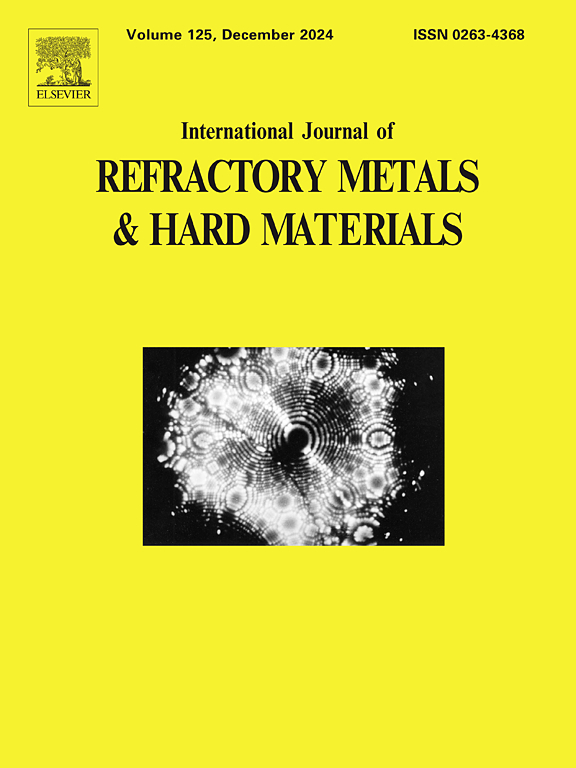Microstructure, mechanical, electrochemical and tribological performances of WC-based cemented carbides with different NbC amounts
IF 4.2
2区 材料科学
Q2 MATERIALS SCIENCE, MULTIDISCIPLINARY
International Journal of Refractory Metals & Hard Materials
Pub Date : 2025-02-15
DOI:10.1016/j.ijrmhm.2025.107099
引用次数: 0
Abstract
WC-based cemented carbides with different NbC amounts (0, 1, 2, 3, 4, and 5 wt%) were prepared by the liquid phase sintering method. When the NbC amount was low, it was uniformly distributed in the cemented carbide and reduced the grain size of WC grains. With the increase of NbC amount, the inhibitory effect of WC grain was weakened, and the (Nb, W)C solid solution was gradually formed. The hardness and impedance modulus (|Z|0.01Hz) of the cemented carbide increased to 1546 ± 7 kg/mm2 and 2200 ± 31 Ω cm2 at 2 wt% NbC. In addition, for additions of 2 wt% NbC, the corrosion current density (icorr) was 4.849 ± 0.5 × 10−6 A/cm2, the coefficient of friction (COF), 0.287 ± 0.004 and the lowest wear rate of 0.85 ± 0.03 × 10−5 mm3/(N⋅m) was observed. Therefore, the WC-based cemented carbides with 2 wt% NbC additive had the best comprehensive properties.
不同NbC用量wc基硬质合金的显微组织、力学、电化学和摩擦学性能
采用液相烧结法制备了不同NbC含量(0、1、2、3、4、5 wt%)的wc基硬质合金。当NbC含量较低时,其在硬质合金中均匀分布,使WC晶粒尺寸减小。随着NbC用量的增加,WC晶粒的抑制作用减弱,逐渐形成(Nb, W)C固溶体。在2 wt% NbC下,硬质合金的硬度和阻抗模量(|Z|0.01Hz)分别提高到1546±7 kg/mm2和2200±31 Ω cm2。当NbC添加量为2 wt%时,腐蚀电流密度(icorr)为4.849±0.5 × 10−6 A/cm2,摩擦系数(COF)为0.287±0.004,磨损率最低为0.85±0.03 × 10−5 mm3/(N·m)。因此,添加2 wt% NbC的wc基硬质合金综合性能最好。
本文章由计算机程序翻译,如有差异,请以英文原文为准。
求助全文
约1分钟内获得全文
求助全文
来源期刊
CiteScore
7.00
自引率
13.90%
发文量
236
审稿时长
35 days
期刊介绍:
The International Journal of Refractory Metals and Hard Materials (IJRMHM) publishes original research articles concerned with all aspects of refractory metals and hard materials. Refractory metals are defined as metals with melting points higher than 1800 °C. These are tungsten, molybdenum, chromium, tantalum, niobium, hafnium, and rhenium, as well as many compounds and alloys based thereupon. Hard materials that are included in the scope of this journal are defined as materials with hardness values higher than 1000 kg/mm2, primarily intended for applications as manufacturing tools or wear resistant components in mechanical systems. Thus they encompass carbides, nitrides and borides of metals, and related compounds. A special focus of this journal is put on the family of hardmetals, which is also known as cemented tungsten carbide, and cermets which are based on titanium carbide and carbonitrides with or without a metal binder. Ceramics and superhard materials including diamond and cubic boron nitride may also be accepted provided the subject material is presented as hard materials as defined above.

 求助内容:
求助内容: 应助结果提醒方式:
应助结果提醒方式:


